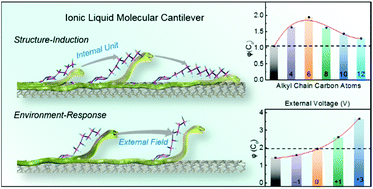A 3D molecular cantilever based on interfacial self-assembly and the cobra-like actuation of long-chain imidazolium ionic liquids†
Abstract
Cantilever structures usually function as a key building block in the construction of supramolecular systems. In this work, based on the controllable interfacial self-assembly of monolayer long-chain imidazolium ionic liquids (ILs) on multi-walled carbon nanotubes, we design a 3D molecular cantilever with advantages including facile assembly, multi-mechanism actuation and high scalability. Molecular dynamics simulations predict that the lifting of the cation alkyl chain as a cantilever possesses a cobra-like actuation mechanism, including structure-induced and environmental response effects, which is further verified via experimental observations. On one hand, regulating the internal alkyl chain units results in the regular variation of the cantilever tilt angle with respect to the surface; on the other hand, applying external electric fields with various strengths/directions can also drive the cantilever to rise or fall. As expected, the interfacial self-assembly structure of the molecular cantilever directionally induces a change in the phase transition behaviour, delivering significantly enhanced thermal stability for immobilized ILs compared with the bulk state.



 Please wait while we load your content...
Please wait while we load your content...